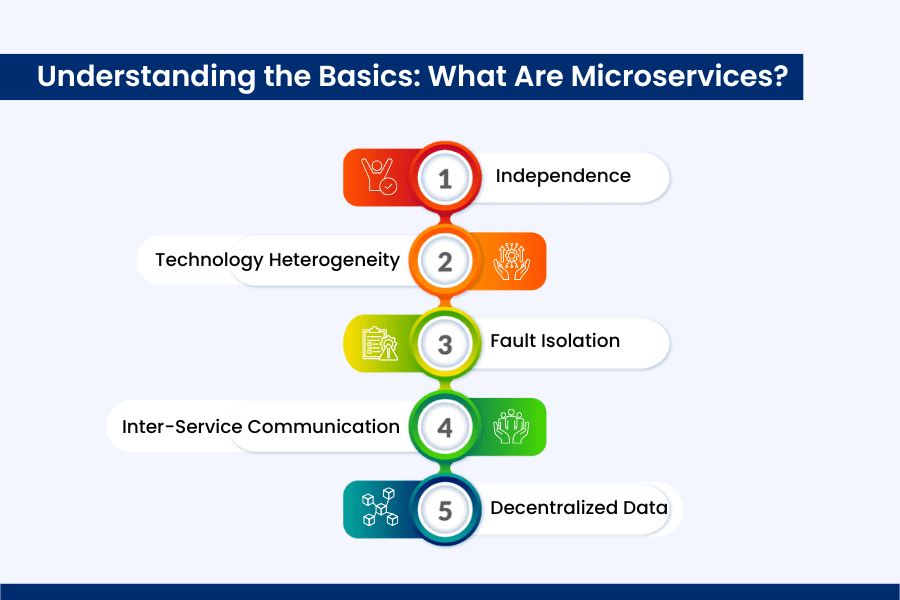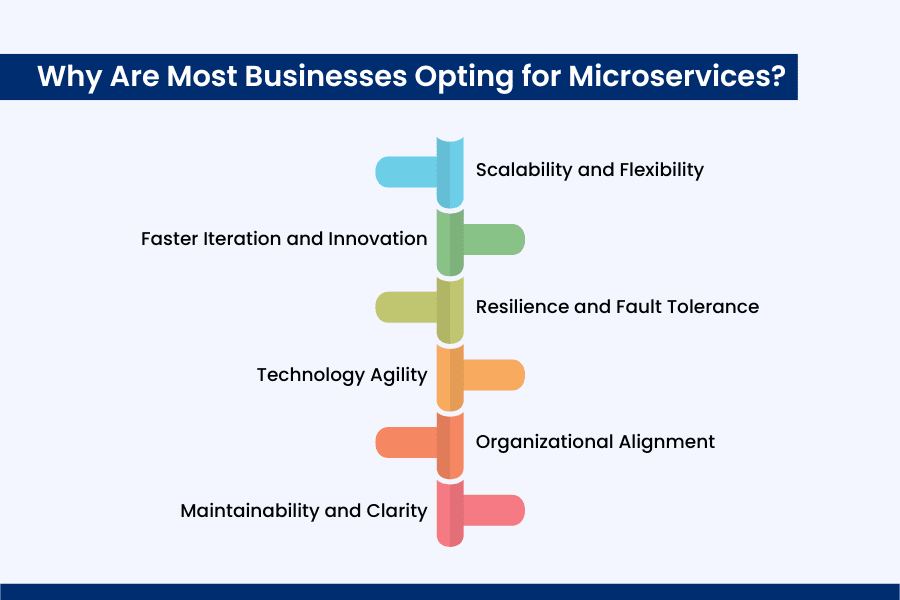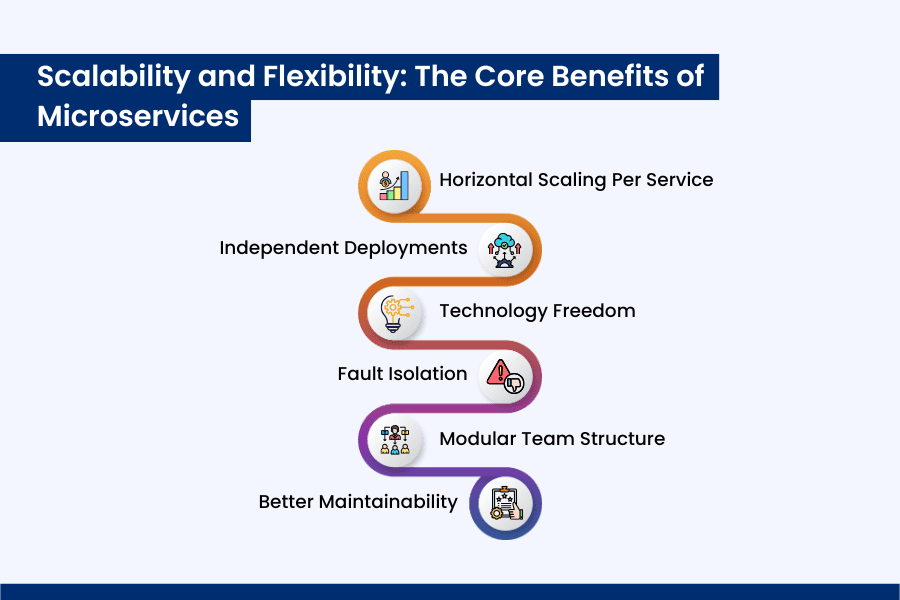
Today, rather than traditional monolithic systems, most modern enterprises rely on microservices (also called micro-services) – a technology rapidly gaining attention as a cure for massive business operations within a unified setup, focusing on individualized development specialities. However, with its evolution, there is a particular portion of enterprises that are yet to explore the potential of microservices architecture.
In this blog, we’ll provide an A-Z guide to help you understand how microservice architectures enhance the power of modern software development. We’ll also relate all of this to custom software development and its services, assisting organizations to reap the full benefits of modern architectures.
- Understanding the Basics: What Are Microservices?
- Why Are Most Businesses Opting for Microservices?
- Microservices vs. Traditional Architectures in Custom Software Development
- Building on a Microservices Platform
- Scalability and Flexibility: The Core Benefits of Microservices
- Challenges and Mitigations in Microservices Adoption
- Conclusion
- FAQs:
Understanding the Basics: What Are Microservices?

Microservices refer to an architectural style where a single application is composed of many small, loosely coupled, and independently deployable services. Each service focuses on a specific business capability, user management, payment processing, inventory updates, search, etc.
Instead of bundling everything into one tightly integrated system, microservices isolate functions. You might also see them labeled as microservices, emphasizing their granularity. Key traits of this pattern include:
- Independence: Each microservice can be developed, deployed, scaled, and maintained on its own.
- Technology Heterogeneity: Services can use different languages, databases, or frameworks suited to their domain.
- Fault Isolation: Failures in one microservice rarely cause a total system shutdown.
- Inter-Service Communication: Typically via lightweight APIs (REST, gRPC, messaging queues).
- Decentralized Data: Rather than a single monolithic database, each microservice often manages its own data store.
In contrast to a monolithic approach, microservices break a system into autonomous modules. This allows development teams to own smaller slices of functionality rather than wrestling with an entire system at once.
Why Are Most Businesses Opting for Microservices?

Transitioning to microservices is yet purely a trend, but it has a significant demand in the market and attention from the top multinational enterprises, as it addresses concrete challenges in software development, such as:
1. Scalability and Flexibility
Monolithic systems often face scaling constraints: scaling one module forces scaling the entire app. With microservices, you can scale just the high-demand services. That capability underpins scalable software development.
2. Faster Iteration and Innovation
Teams can push small changes to individual services without coordinating across a large monolith, accelerating delivery cycle times.
3. Resilience and Fault Tolerance
Because each service is isolated, a fault in one area (e.g., payment) doesn’t necessarily bring down unrelated parts (e.g., product catalog).
4. Technology Agility
Teams aren’t locked into a single tech stack; they can choose languages or data stores that best suit each service’s needs.
5. Organizational Alignment
Each service aligns with a specific business domain, allowing dedicated teams to manage and deliver complete feature sets independently.
6. Maintainability and Clarity
Smaller codebases per service are easier to understand, test, and refactor.
Thus, microservices are not just a rhetorical question; they’re a response to the limitations of monoliths and legacy systems. In modern software development, these advantages provide companies with a real competitive edge.
Microservices vs. Traditional Architectures in Custom Software Development
When businesses invest in custom software development, they often begin with monolithic or layered architectures — workable at smaller scales but increasingly fragile as systems grow. As the feature count grows, coupling explodes, deployments slow, and even minor updates carry major risks.
Adopting microservice architecture in custom software development services enables modular growth. Teams start with a minimal set of core services and expand organically as new requirements emerge. Instead of stacking layers onto a single codebase, they add new services that integrate cleanly, keeping the system agile and manageable.
For example, consider an e-commerce platform custom-built for a retailer. In a monolithic build, modules like the shopping cart, catalog, order management, user profiles, search, recommendation engine, etc., all live together. Over months, changes in one area create ripple effects. In contrast, a microservices design isolates each function. If the search module needs more database capacity, only that service scales. The cart logic can evolve independently without affecting the catalog or user data.
To guide organizations in migrating legacy systems and designing new architectures around microservices, a software development company that offers both enterprise and custom software development can support flexible and long-term growth.
Building on a Microservices Platform
A microservices platform is the infrastructure and tooling layer that underpins microservices projects. It typically includes:
- Service discovery and registry (so services find each other)
- API gateway and routing
- Load balancing
- Circuit breakers, retries, fallback patterns
- Monitoring, logging, and distributed tracing
- Container orchestration (e.g., Kubernetes, Docker Swarm)
- Messaging or event buses (e.g., Kafka, RabbitMQ)
- Security, identity, and access management
By standardizing on such infrastructure, teams can focus on domain functionality rather than reinventing plumbing. A mature software development services provider usually delivers a baseline microservices platform and then builds services on top of it.
Using such a platform also enhances scalability and flexibility. For instance, the API gateway can shard traffic to instances of specific services; a messaging bus enables eventual consistency across modules; observability tools help trace cross-service flows.
For enterprises working with a software development company, adopting a microservices platform reduces time to market and ensures consistent practices across all microservices.
Scalability and Flexibility: The Core Benefits of Microservices

Let’s dig deeper into how microservices deliver scalability and flexibility:
1. Horizontal Scaling Per Service
If your “checkout” microservice becomes a bottleneck during peak sales, you add instances only for that service, not the entire system. You can even use auto-scaling based on metrics.
2. Independent Deployments
Teams can deploy updates to one service without coordinating changes across the entire system. That yields quicker releases, confident rollbacks, and minimal downtime.
3. Technology Freedom
One microservice might use a graph database, another a relational store, one in Go, another in Node.js, dependent on need. That flexibility encourages optimization per module.
4. Fault Isolation
If a service fails or becomes slow, circuit breakers and fallback patterns isolate it, reducing blast radius. The rest of the system continues working.
5. Modular Team Structure
Teams can focus on bounded contexts or domains. That clarity helps align dev, QA, and operations around capability boundaries.
6. Better Maintainability
Because each service is smaller, the code base is more understandable. Refactoring, testing, and code reviews are more manageable.
Thus, microservices are a foundational pillar for scalable software development and long-term adaptability.
Challenges and Mitigations in Microservices Adoption
While powerful, microservices carry complexity. A software development company or team considering them must navigate:
- Operational Overhead: Multiple deployments, monitoring, versioning, and infrastructure.
Mitigation: Use mature microservices platforms and DevOps automation.
- Distributed Systems Complexity: Latency, partial failure, and network partition issues.
Mitigation: Adopt patterns like circuit breakers, retries, and bulkheads.
- Data Consistency: With multiple data stores, transactional consistency is tricky.
Mitigation: Use eventual consistency models, sagas, or event sourcing.
- Service Granularity: If the services are defined too broadly, you lose the core advantages of microservices; if they’re split too narrowly, managing them becomes unnecessarily complex and resource-intensive.
Mitigation: Define bounded contexts and measure coupling.
- Cross-Cutting Concerns: Logging, tracing, and security must be consistent across services.
Mitigation: Use central libraries or middleware in your microservices platform.
- Testing and Debugging: End-to-end flows span many services.
Mitigation: Automated integration testing, contract testing, and distributed tracing.
When a software development services firm guides adoption, it typically addresses these through best practices, training, infrastructure, and observability tooling. The move to microservices should be gradual; not all systems need rewriting at once.
Conclusion
In modern software development, microservices architecture offers a compelling path to building systems that are resilient, evolvable, and scalable. By understanding what microservices are and why microservices are increasingly prevalent, organizations and technology partners can embark on transformations that deliver lasting benefits in performance, maintainability, and agility.
When combined with dedicated custom software development services and backed by a robust microservices platform, teams can accelerate innovation while maintaining stability. Whether you lead a startup or head the engineering division of a large enterprise, microservices represent a powerful paradigm for architecting for the future. At Soluzione, we help enterprises transform their legacy systems into modular, high-performing software ecosystems built on a microservices architecture. Connect with us to know more.
FAQs:
How does microservices architecture differ from monolithic architecture?
In a monolithic architecture, all components of an application are built as a single, unified system, meaning updates or scaling affect the entire app. In contrast, microservices architecture breaks the application into smaller, loosely coupled services that can be developed, deployed, and scaled independently, making the system more agile and resilient.
What are the main benefits of adopting microservices in modern applications?
The key benefits include improved scalability and flexibility, faster time to market, easier maintenance, fault isolation, and technology diversity. Teams can work on different services simultaneously, enabling continuous innovation and efficient scaling of high-demand services.
Can microservices architecture improve scalability for growing businesses?
Yes. Microservices architecture allows organizations to scale only the components that require additional resources instead of scaling the entire system. This leads to scalable software development, cost optimization, and better performance as the business grows.
How do microservices enhance flexibility in software development?
Microservices give teams the freedom to use different programming languages, databases, or frameworks best suited to each service’s purpose. This independence enhances custom software development and allows for quick updates, experimentation, and smoother integration with emerging technologies.
What role do APIs play in microservices architecture?
APIs serve as the communication bridge between microservices. They enable services to interact securely and efficiently without depending on each other’s internal logic. In essence, APIs ensure that independently developed microservices work together seamlessly as a unified application.










